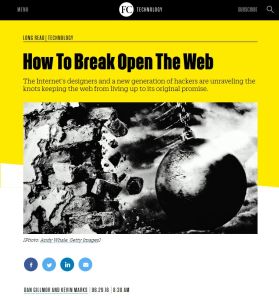Join getAbstract to access the summary!

Join getAbstract to access the summary!
Dan Gillmor
How To Break Open The Web
Fast Company, 2016
What's inside?
Does an increasingly centralized, privatized Internet violate peoples’ right to privacy?
Recommendation
People have come to accept that they must trade elements of privacy for permission to access the Internet. But many in the tech world see this exchange as a betrayal of the web’s original promise of freedom for all. Digital media professor Dan Gillmor and software engineer Kevin Marks explore how the present, centralized web emerged; why the limitations that the centralized system imposes deserve critique; and how alternative, decentralized systems might offer a counterbalance to governmental and corporate control of the Internet. getAbstract recommends this article to tech trend watchers and all those interested in Internet freedom.
Summary
About the Author
Dan Gillmor authored the book Mediactive and teaches digital media at Arizona State University. Kevin Marks is a software engineer who believes “human problems are the most interesting to solve.”
















Comment on this summary